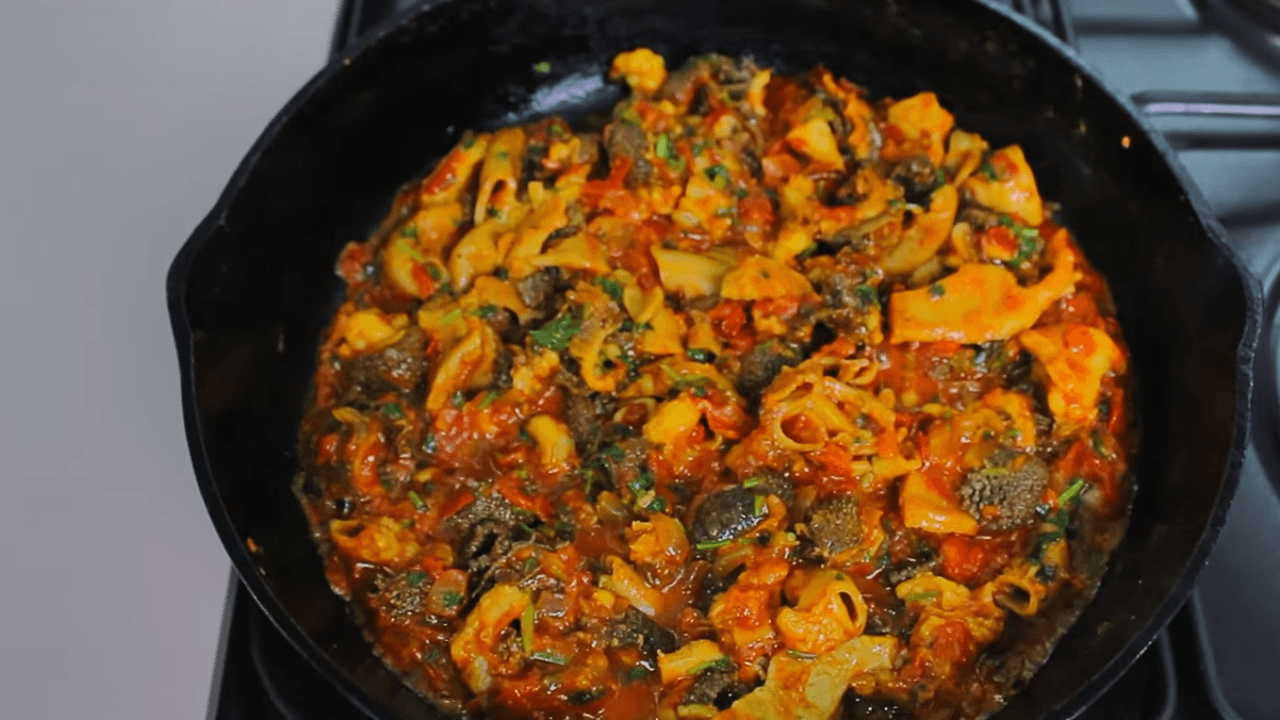Some links on this page are affiliate links. This means we may earn a commission at no additional cost to you if you click through and make a purchase, you can check our Affiliate Disclosure. Thank you for your support!
Matumbo foods, a dish rich in history and flavor, has been a staple in many African households for generations. This unique dish has much to offer regarding taste, texture, and cultural significance, making it a must-try for food enthusiasts worldwide. In this guide, we’ll go into great detail about Matumbo. We’ll talk about where it came from, how famous it is in different parts of Africa, and why so many people love it.
What is Matumbo?
Matumbo is a traditional African dish primarily made from beef tripe, which is the stomach lining of a cow. The tripe is thoroughly cleaned, boiled until tender, and then stewed with various aromatic spices, onions, tomatoes, and sometimes, additional vegetables. The result is a savory, hearty stew that is both flavorful and satisfying.
From East Africa, Matumbo has a rich history deeply rooted in African culinary traditions. It is trendy in countries like Kenya, Tanzania, and Uganda. The name ‘Matumbo’ is Swahili, reflecting its East African roots. This dish is not just a feast for the senses, but also holds cultural significance, often served during special occasions and gatherings.

The Popularity of Matumbo Foods Across Africa
Matumbo’s popularity transcends borders, with variations of the dish being found in different regions across the African continent. While the essential ingredients remain the same, the preparation methods and accompanying spices and vegetables can vary, giving each region’s version of Matumbo its unique twist.
In Kenya, it is often enjoyed with Ugali, a cornmeal porridge, creating a hearty and fulfilling meal. In Uganda, you might find it served with Matoke, a dish made from bananas, adding a unique flavor profile to the feed. In Tanzania, it might be enjoyed with a side of rice or Chapati, a type of flatbread.
These regional variations showcase the versatility of it and how it has been embraced and adapted to suit the local tastes and preferences of people across Africa. Its widespread popularity is a testament to its deliciousness and the vital role it plays in African cuisine.
Key Ingredients in Matumbo Food
To truly appreciate Matumbo foods, it is essential to understand the key ingredients that come together to create this delectable dish. From the primary component, beef tripe, to the array of supporting ingredients and spices, each plays a crucial role in developing the rich flavors and textures that make Matumbo unique.
The Role of Beef Tripe
Beef tripe is the star of the show when it comes to Matumbo. Derived from the stomach lining of a cow, beef tripe has a distinctive texture and flavor that, when prepared correctly, adds a unique depth to the dish. The preparation of beef tripe is a meticulous process. It requires thorough cleaning to remove impurities and a lengthy boiling period to ensure it is tender.
The tripe is usually boiled with aromatic ingredients like garlic and ginger, as well as a pinch of salt, to infuse it with flavor right from the start. Once tender, the tripe is cut into bite-sized pieces and then stewed with the other ingredients to create the final Matumbo dish. The proper preparation of beef tripe is crucial, as it ensures not just the right texture and flavor, but also makes the word more enjoyable and safe to eat.

Supporting Ingredients and Spices
While beef tripe is undoubtedly the main ingredient in Matumbo, the dish would only be complete with its supporting cast of ingredients and spices. These include:
Onions and Garlic: These aromatics form the stew’s base, creating a flavorful foundation for the dish.
Tomatoes: Fresh tomatoes add a touch of sweetness and acidity, balancing out the rich flavors of the beef tripe.
Bell Peppers: Bell peppers contribute slightly bitterness and crunch, adding another layer of flavor and texture.
Spices: Spices can vary depending on the region, but standard options include paprika, cayenne pepper, and coriander. These spices help to elevate the dish, providing warmth, heat, and complexity.
Fresh Herbs: Parsley or coriander leaves are often used as a garnish, adding freshness and color to the dish.
Lime or Lemon Juice: Lime or lemon juice just before serving enhances the flavors and adds a zesty kick.
Together, these ingredients and spices meld with the beef tripe, creating a harmonious and flavorful stew that is comforting and exciting to the palate. The balance of textures and flavors makes Matumbo such a beloved dish across Africa and beyond.
The Unique Taste and Texture of Matumbo Food
Matumbo is a dish that stands out not just for its rich cultural history but also for its unique taste and texture, both of which are integral to its appeal. The combination of savory flavors and the distinct texture of beef tripe creates a culinary experience like no other.
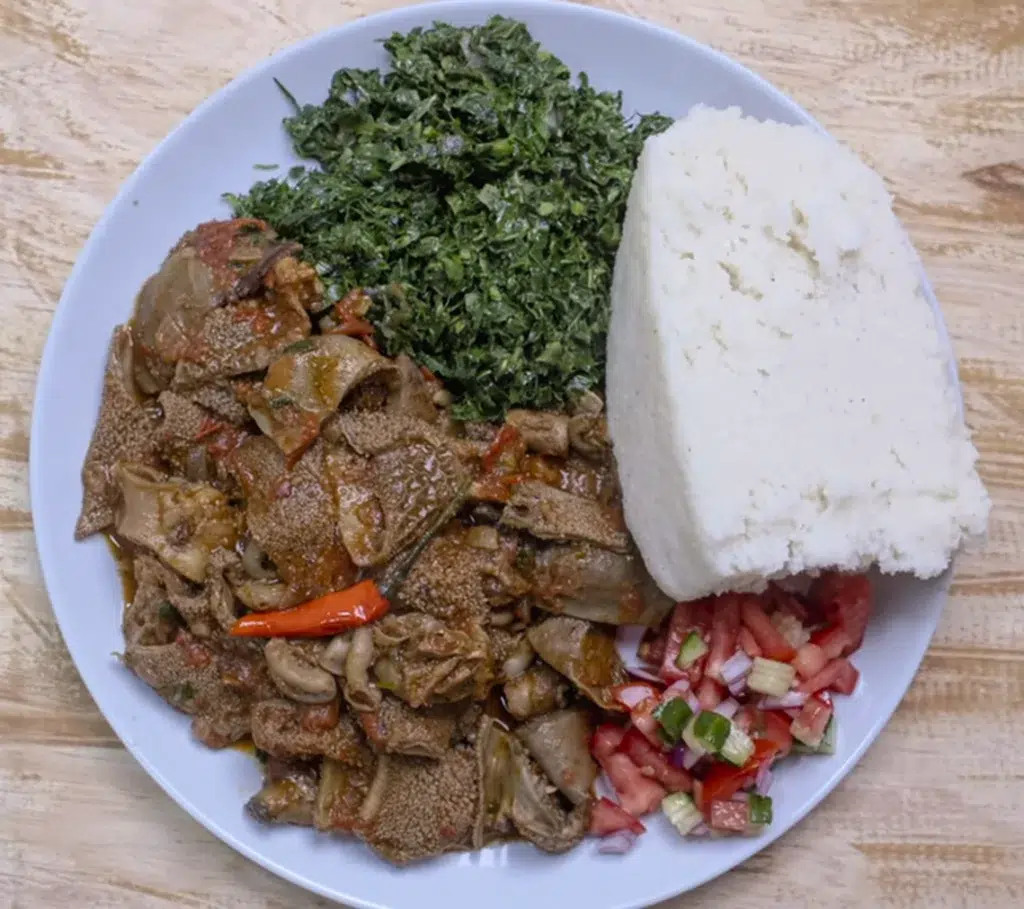
Savoring the Flavor
The flavor profile of Matumbo food is deep, rich, and savory. The beef tripe has a mild, somewhat nutty taste that absorbs the flavors of the spices and aromatics it is cooked with. The stewing process allows the tripe to soak up the savory goodness of onions, garlic, and tomatoes, while the spices add warmth and a gentle heat that tickles the palate.
Using fresh herbs and a squeeze of lime or lemon juice before serving introduces freshness and acidity, balancing out the rich flavors and adding an extra layer of complexity. The result is a dish that is hearty, comforting, and immensely satisfying, with a taste that lingers on the palate, inviting you to savor each bite.
Appreciating the Texture
The texture of beef tripe is unlike any other meat, and it plays a significant role in the appeal of Matumbo Food. When adequately prepared, the tripe is tender yet slightly chewy, providing a satisfying mouthfeel that adds to the overall dining experience.
The unique texture of the tripe, combined with the other ingredients in the dish, creates a contrast that is both interesting and delightful. The softness of the stewed vegetables complements the chewiness of the tripe, while the occasional crunch from the bell peppers adds an element of surprise. This interplay of textures makes each bite of Matumbo a journey of discovery, engaging the senses and leaving a lasting impression.
Health Benefits and Nutritional Value of Matumbo
While Matumbo is certainly a flavorful and culturally rich dish, it also offers a variety of health benefits and nutritional value, primarily due to its main ingredient, beef tripe. In this section, we will delve into the dietary components of beef tripe and explore how Matumbo can be incorporated into a balanced diet.
Nutritional Components of Beef Tripe

Beef tripe is a good source of essential nutrients contributing to overall health. Here’s a closer look at its nutritional profile:
Protein: Beef tripe is rich in protein, an essential macronutrient that supports muscle growth, repair, and overall body function.
Vitamins: It contains a range of B-vitamins, including B12, niacin, and riboflavin, which play a crucial role in energy production, brain function, and the maintenance of healthy skin and eyes.
Minerals: Beef tripe provides essential minerals such as zinc, selenium, and phosphorus. Zinc helps the immune system work and wounds heal. Selenium protects cells from damage as an antioxidant, and calcium is important for strong bones and teeth.
Low in Fat: Compared to other cuts of beef, tripe is relatively low in fat, making it a leaner protein option.
Even though beef tripe has these health benefits, it is important to remember that it is high in cholesterol. People who need to watch their cholesterol diet should eat it in moderation.
How Matumbo Fits into a Balanced Diet
Incorporating Matumbo food into a balanced diet can be both nutritious and delicious, provided it is consumed in moderation and accompanied by various other foods. Here are some tips on how to enjoy Matumbo as part of a healthy eating plan:
Balance with Vegetables: Enhance the nutritional value of your Matumbo meal by serving it with a generous portion of vegetables. This could be in the form of a side salad or additional vegetables cooked into the stew.
Choose Whole Grains: Pair Matumbo food with whole grains such as brown rice, quinoa, or whole-wheat chapati for added fiber and nutrients.
Watch Portion Sizes: Like any dish, it’s essential to be mindful of portion sizes. Enjoying Matumbo in moderation ensures you reap the benefits without overindulging.
Limit Added Fats: When preparing Matumbo, be mindful of added fats, such as cooking oil, to keep the dish as lean and healthy as possible.
By following these guidelines, you can enjoy the rich flavors and unique textures of Matumbo while maintaining a balanced and health-conscious diet.
Cooking Tips and Tricks for Perfect Matumbo Food
Matumbo is a dish that requires careful preparation and patience, but the result is a savory, hearty stew worth the effort. Below, we provide some crucial tips and techniques to help you prepare Matumbo like a pro, ensuring that the beef tripe is tender and the flavors are well-balanced.
Preparing Beef Tripe
The first and most crucial step in making Matumbo is preparing the beef tripe. Here’s how to do it right:
Cleaning the Tripe: Beef tripe needs to be cleaned thoroughly to remove any impurities and to ensure it is safe to eat. Rinse the tripe under cold running water, scrubbing off any debris or fat. Some people also like to use salt or vinegar during the cleaning process for an extra level of sanitation.
Removing the Fat: After rinsing, inspect the tripe for any remaining fat and trim it off. This step is crucial as it ensures that the tripe will be tender once cooked.

Boiling: Place the cleaned tripe in a large pot of boiling water. Add some salt, a few cloves of garlic, and a slice of ginger. These aromatics will help to remove any unwanted smells and will start to infuse the tripe with flavor. Boil the tripe for several hours until it is tender. The exact cooking time will depend on the type of tripe and your personal preference for tenderness.
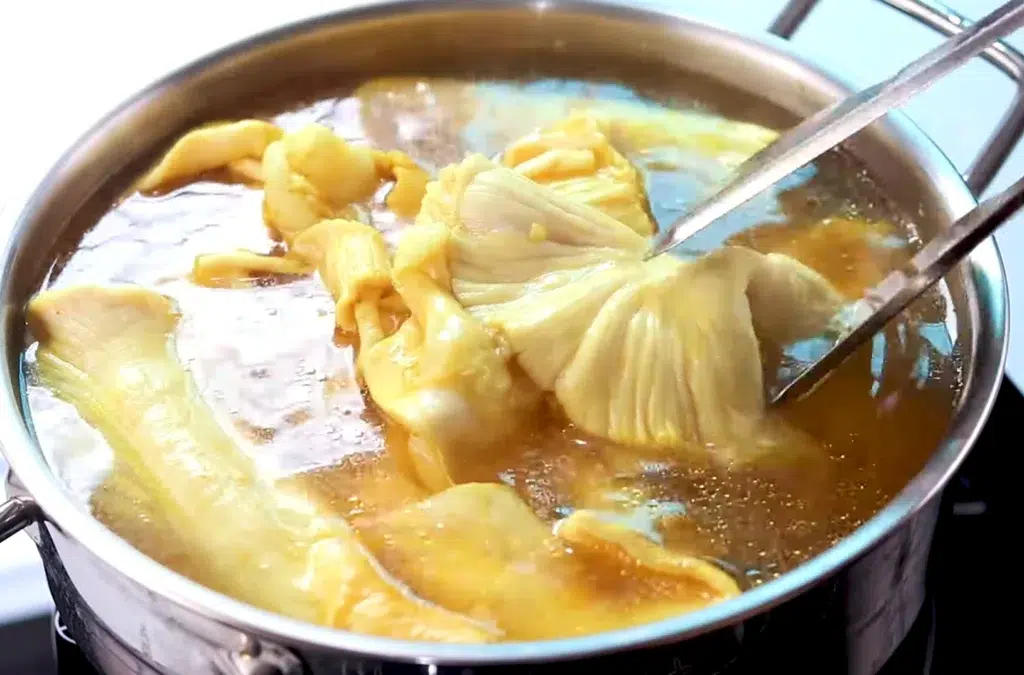
Cutting: Once the tripe is tender, drain it and let it cool. Then, cut it into bite-sized pieces, ready to be added to the stew..

ALSO READ: Delicious Shakshuka Recipe: A Guide To Making The Perfect North African Egg Dish
Cooking Techniques for Matumbo Food
With your beef tripe prepared, you’re ready to start cooking Matumbo. Follow these steps to create a delicious stew:
Sautéing Aromatics: In a large pot, sauté onions, and garlic in a little bit of oil until they are translucent and fragrant. This creates the flavorful base for your stew.
Adding Tomatoes and Spices: Add chopped tomatoes and your choice of spices. Standard options include paprika, cayenne pepper, and a touch of curry powder. Cook until the tomatoes break down and form a rich sauce.
Stewing the Tripe: Add the prepared beef tripe to the pot, along with enough water or beef broth to cover. Bring to a simmer and let it cook for at least 30 minutes to an hour, allowing the flavors to meld together.
Seasoning and Finishing: Season the stew with salt and pepper to taste. A squeeze of lime or lemon juice before serving will add a zesty kick and balance out the flavors.
By following these tips and techniques, you’ll be able to create a Matumbo dish that is flavorful, tender, and genuinely authentic.
Delicious Matumbo Food Recipes to Try at Home
Matumbo is a beloved dish across many African communities. Its rich flavors and unique texture make it a must-try for food enthusiasts. Here, we provide a classic recipe for those looking to experience traditional Matumbo, as well as some modern twists for those eager to experiment.
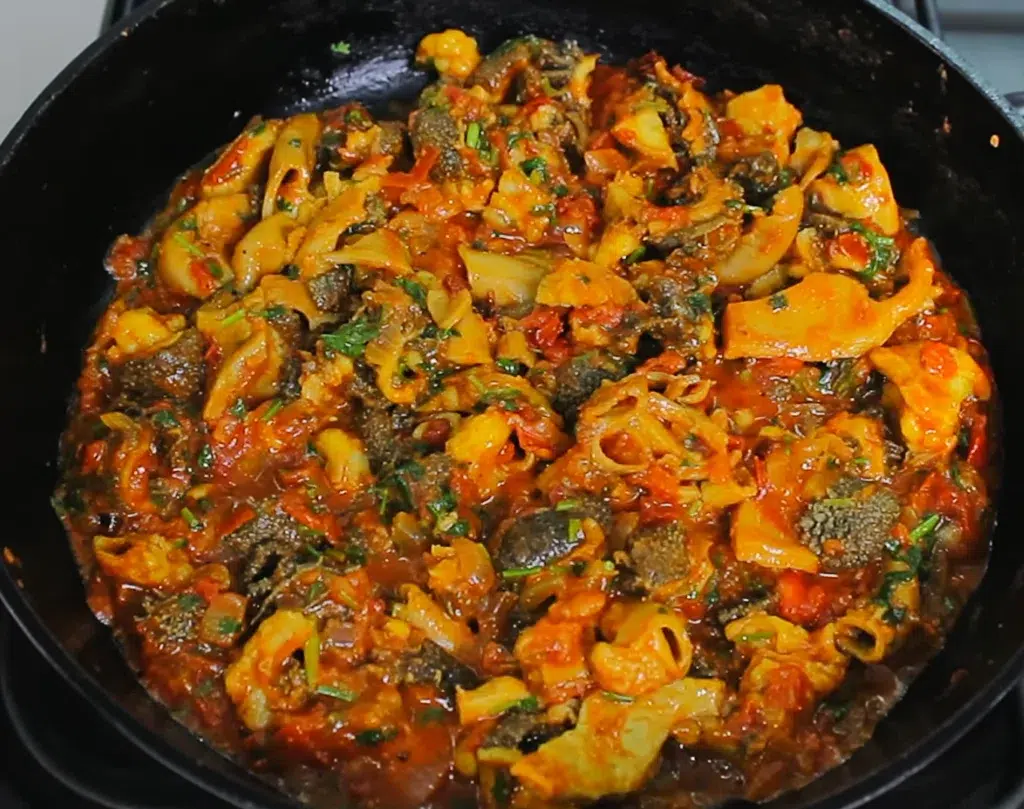
Traditional Matumbo Recipe
Experience the authentic taste of African cuisine with this classic Matumbo recipe:
Ingredients:
500g cleaned and pre-boiled beef tripe, cut into bite-sized pieces
2 large onions, finely chopped
4 cloves of garlic, minced
3 ripe tomatoes, blended
1 tablespoon tomato paste (optional, for a richer color and taste)
1 bell pepper, chopped
Fresh coriander leaves, chopped
1 teaspoon paprika
1/2 teaspoon cayenne pepper (adjust according to taste)
Salt to taste
2 tablespoons cooking oil
Water or beef broth, as needed
Instructions:
In a large pot, heat the cooking oil over medium heat. Add the onions and sauté until they become translucent.
Add the minced garlic and continue to sauté for about a minute until it becomes aromatic.
Stir in the blended tomatoes, tomato paste (if using), paprika, cayenne pepper, and salt. Let it cook for 5-7 minutes, or until the tomatoes are well cooked and the mixture has thickened.
Add the chopped bell pepper and mix well.
Add the pre-boiled beef tripe to the pot, stirring well to ensure that it’s fully coated with the tomato mixture.
Cover the tripe with enough beef broth or water. To make the stew thicker and the tripe soft, turn down the heat after it starts to boil and let it cook slowly for 20 to 30 minutes.
Adjust the seasoning if necessary, then stir in the fresh coriander leaves.
Serve hot with your preferred side dish, and enjoy your traditional Matumbo meal!
Modern Twists on Matumbo
If you’re looking to give this traditional dish a contemporary spin, here are some innovative ideas:
Matumbo Tacos: Top Matumbo with a fresh salsa made of diced tomatoes, onions, cilantro, and a squeeze of lime juice. Serve on soft taco shells.
Creamy Matumbo: Add a touch of cream or coconut milk to the stew for a richer, creamier texture.
Spicy Matumbo: For those who love heat, add more chili peppers or a splash of hot sauce to give your Matumbo an extra kick.
Matumbo Stir Fry: Sauté the boiled tripe with an assortment of vegetables like bell peppers, carrots, and snap peas—season with soy sauce, ginger, and garlic for an Asian-inspired twist.
Baked Matumbo: Put the Matumbo in a baking dish and top it with grated cheese. Put it in the oven and bake it until the cheese melts and the top turns golden brown. This is going to be a warm casserole-style meal.
By experimenting with these recipes and ideas, you can enjoy Matumbo in various delightful ways, bringing a taste of Africa to your kitchen with both traditional and modern touches.
How to Serve and Enjoy Matumbo
Matumbo is not just a dish; it’s an experience. Serving it the right way enhances its flavors and makes the meal memorable. Here’s how you can serve and enjoy Matumbo like a pro.
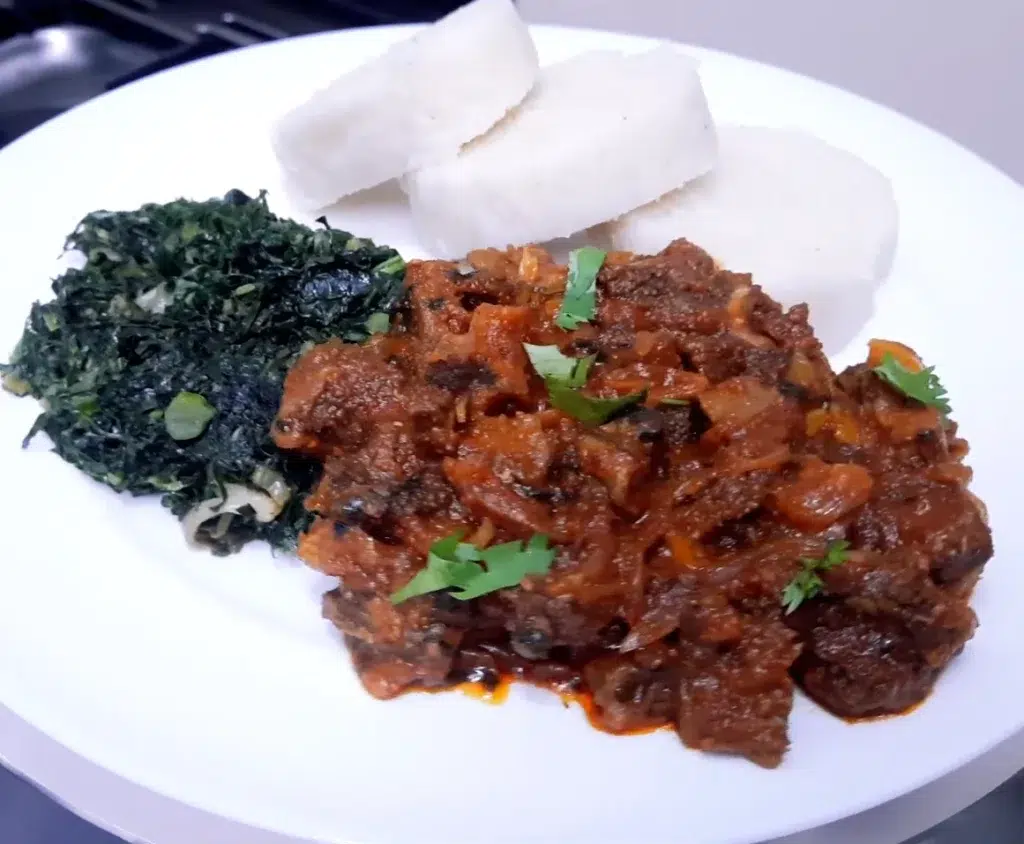
Traditional Accompaniments
The rich and savory flavors of Matumbo pair well with a variety of side dishes and condiments. Here are some traditional options:
Ugali: A staple in many East African homes, Ugali is a dense porridge made from maize flour and water. Its bland taste complements the rich flavors of Matumbo perfectly.
Rice: A side of plain boiled rice or pilau (spiced rice) can also serve as a great accompaniment, providing a balance to the dish.
Chapati: Soft, layered flatbreads can be used to scoop up the Matumbo, adding a different texture to the meal.
Steamed Vegetables: Simple steamed vegetables like spinach, kale, or collard greens add a healthy and light side option.
Kachumbari: A fresh tomato and onion salad, often with a hint of chili and a squeeze of lemon juice, adds a refreshing contrast to the rich stew.
Tips for Serving Matumbo
Presentation and serving style play a crucial role in enjoying Matumbo to the fullest. Here are some tips:
Serve Hot: Matumbo is best enjoyed hot. Ensure that it’s served straight off the stove or kept in a warmer until ready to serve.
Garnish: Garnish the Matumbo with fresh chopped coriander or parsley just before serving. This adds a burst of color and freshness.
Balance the Portions: Ensure there is a good balance between the Matumbo and the side dishes. You want to make sure the plate is manageable with one thing.
Communal Serving: In many African households, Matumbo is served in a communal dish, promoting sharing and a sense of community. Consider this approach if you’re serving a larger group.
Condiments on the Side: Offer a variety of herbs on the side, such as hot sauce, lemon wedges, or extra salt, allowing guests to adjust the seasoning to their liking.
Provide Handwashing Facilities: Eating Matumbo can be a hands-on experience, primarily if you’re serving it with Ugali or Chapati and providing a bowl of water with a slice of lemon or a damp cloth for guests to clean their hands before and after the meal adds a thoughtful touch.
By pairing Matumbo with the right accompaniments and ensuring it’s served with care, you’re guaranteed to have a delightful culinary experience that celebrates the rich flavors and cultural significance of this beloved dish. Enjoy your meal!
Matumbo Food Across the World
Matumbo, a traditional African dish predominantly enjoyed in East African countries, has seen a surge in popularity and appreciation across the globe. Its unique taste, rich history, and cultural significance have captured the attention of food enthusiasts worldwide. In this section, we delve into its presence in the global culinary scene and provide advice on sourcing its unique ingredients abroad.
Matumbo Food in the Global Culinary Scene
As global interest in diverse cuisines continues to grow, Matumbo food has found its way onto the plates of food lovers around the world. Here’s how:
Fusion Cuisine: Chefs in various parts of the world are experimenting with Matumbo food, incorporating it into fusion dishes that combine elements from different culinary traditions. For instance, Matumbo tacos or Matumbo-infused pastas.
Ethnic Restaurants: The rise of African restaurants in major cities across Europe, North America, and Asia has played a significant role in introducing Matumbo to a broader audience.
Culinary Events and Food Festivals: Matumbo is increasingly featured in food festivals and culinary events dedicated to showcasing African cuisine, drawing attention from food critics and enthusiasts alike.
Cooking Shows and Online Platforms: The dish has made appearances on popular cooking shows and online recipe platforms, further increasing its visibility and encouraging food lovers to try making it at home.
Word of Mouth: As people travel and explore different cuisines, word of mouth has played a crucial role in spreading the love for Matumbo far and wide.
Finding Matumbo Ingredients Abroad
While Matumbo is a dish rich in flavor and tradition, sourcing its unique ingredients, particularly beef tripe, can be challenging outside Africa. Here are some tips to help:
Ethnic Grocery Stores: Look for African, Caribbean, or Latin American grocery stores in your area. These stores often stock beef tripe and other ingredients essential for making Matumbo.
Butchers and Specialty Stores: Some butchers and specialty food stores offer a variety of meats, including beef tripe. Feel free to ask if they can order it for you if it’s not readily available.
Online Retailers: There are online platforms that specialize in African groceries or hard-to-find ingredients. You should be able to find a good store with a quick internet search.
Local Farmer’s Markets: Sometimes, local farmers and producers at farmer’s markets might have access to beef tripe or can point you in the right direction.
Building a Network: Connecting with local African communities can be invaluable. They can provide tips on where to source ingredients or even share some of their own.
DIY Ingredients: For some of the spices or condiments specific to Matumbo, consider making them at home if you can’t find them in stores. There are plenty of online resources with recipes and instructions.
By exploring these avenues, you can bring the authentic flavors of Matumbo to your kitchen, no matter where in the world you are. Enjoy the global culinary adventure!
ALSO READ: Party Perfect: Discover 25+ Finger Foods And Appetizers To Wow Your Guests!
Why You’ll Fall in Love with Matumbo
As we’ve explored throughout this comprehensive guide, Matumbo is a dish with deep cultural roots and a rich flavor profile that has won over palates across the globe. Here, we summarize the key points and reiterate why Matumbo is a culinary experience that’s genuinely worth falling in love with.
Rich Cultural Significance: Originating from East Africa, Matumbo is more than just a meal; it’s a celebration of tradition and community. Its preparation and enjoyment bring people together, making it a dish steeped in cultural significance.
Unique Taste and Texture: The combination of tender beef tripe, savory spices, and aromatic vegetables results in a rich and flavorful stew. The unique texture of the tripe, when cooked to perfection, offers a mouthfeel that’s unparalleled, providing a feast for the senses.
Versatility in Cooking: Whether you’re trying the traditional recipe or experimenting with modern twists, Matumbo offers a canvas for culinary creativity. Its ability to meld with various ingredients makes it a versatile choice for any kitchen.
Nutritional Benefits: Packed with essential nutrients, Matumbo Food offers a protein-rich option that can be incorporated into a balanced diet. Its nutritional profile adds to its appeal, making it a hearty and health-conscious choice.
Accessibility Worldwide: With the global appreciation of Matumbo growing, sourcing the ingredients to create this dish has become more accessible, even outside Africa. The shared knowledge and availability of products allow food enthusiasts from all corners of the world to explore and enjoy Matumbo.
Ease of Preparation: Matumbo looks like a dish from far away, but it’s actually very easy to make at home. The straightforward cooking process, coupled with the accessibility of ingredients, makes it a practical yet exciting option for home cooks.
A Culinary Adventure: Trying Matumbo is embarking on a culinary adventure, exploring new flavors, textures, and cooking techniques. It’s an opportunity to broaden your food horizons and indulge in a unique gastronomic experience.
In essence, Matumbo is more than just a dish; it’s a culinary journey filled with flavor, tradition, and the joy of discovery. This food will win your heart and stay with you forever because of its complex flavor, cultural history, and popularity around the world. So, dive in, explore the world of Matumbo Food, and discover why this African delicacy has become a beloved choice for food lovers worldwide. Enjoy your culinary adventure with Matumbo Food!
ALSO READ: Asian Side Dishes – Impress Every Guest With 25+ Feast-Worthy Asian Side Dishes
Frequently Asked Questions About Matumbo Food
Matumbo, with its unique ingredients and preparation method, often piques the interest of many culinary enthusiasts. Here, we address some of the most commonly asked questions to help demystify this delicious African delicacy.
What Does Matumbo Food Taste Like?
Matumbo has a rich, savory taste, with the flavors of beef tripe being prominent. The tripe is typically stewed with various aromatic vegetables, spices, and sometimes, tomatoes, which add layers of flavor. The result is a hearty, flavorful stew with a slightly earthy undertone. Adding local spices and herbs enhances the taste, making it a unique and delightful culinary experience.
Is Beef Tripe in Matumbo Healthy?
Yes, beef tripe, the main ingredient in Matumbo, is a good source of protein and various nutrients such as selenium, zinc, and vitamin B12. It is also low in fat, making it a healthier meat option. However, it’s important to note that beef tripe should be thoroughly cleaned and properly cooked to ensure safety and hygiene. Including various vegetables in your Matumbo will add to its nutritional value and make it a balanced and healthy meal.
Can I Make Matumbo Without Certain Traditional Ingredients?
Yes, Matumbo can be adapted based on availability of ingredients and personal preferences. While some traditional spices and vegetables are commonly used, you can substitute or omit them. The key is to maintain the balance of flavors and ensure that the beef tripe is well-cooked and flavorful. Feel free to experiment and make the dish your own, considering the rich, savory profile that defines Matumbo Food.

